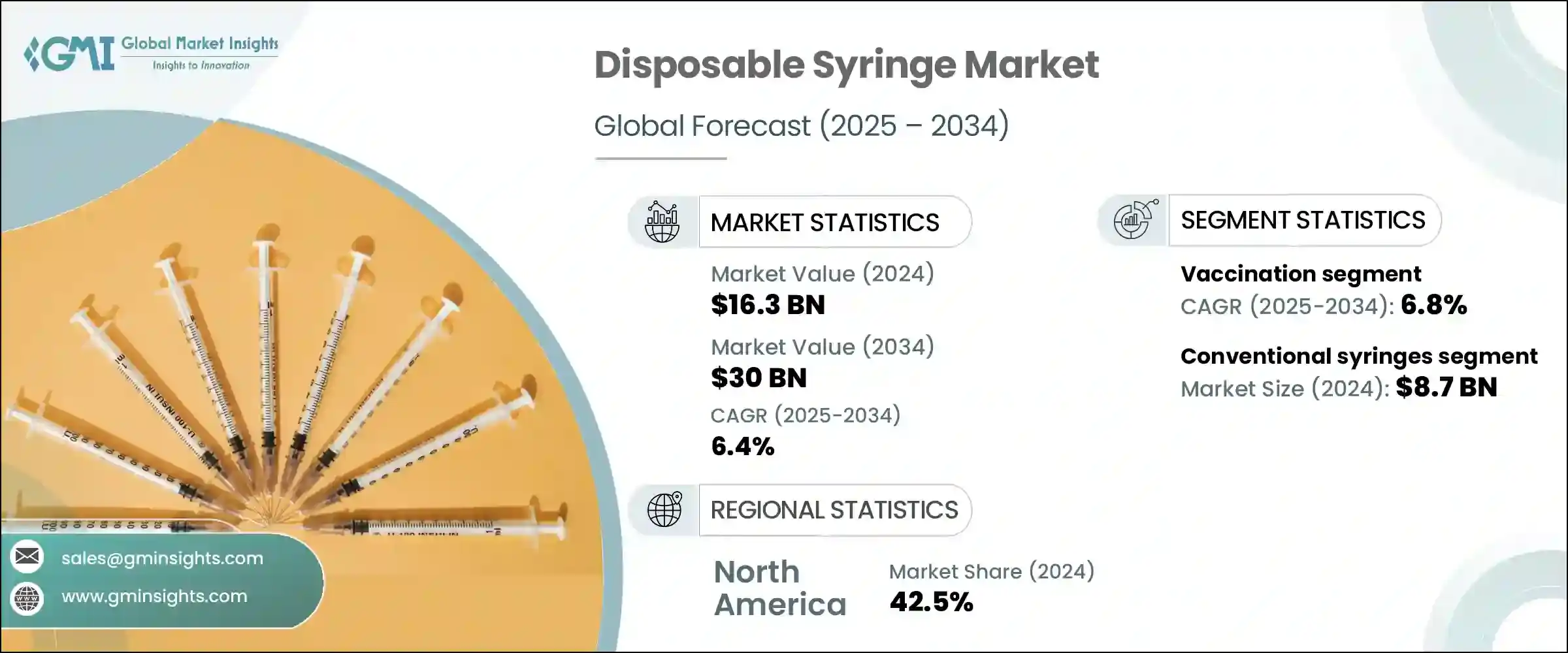
세계의 일회용 주사기 시장은 2024년에는 163억 달러로 평가되었고, CAGR 6.4%를 나타내 2034년까지는 300억 달러에 이를 것으로 추정되고 있습니다. 현대의 라이프 스타일에 따른 건강 합병증 증가가 안전하고 위생적이고 정확한 약물전달 도구 수요에 박차를 가하고 있습니다. 일회용 주사기는 특히 장기간의 치료가 필요한 환자에서 교차 오염의 위험을 최소화하고 정확한 투여를 보장하는데 중요한 역할을 하고 있습니다.

세계의 예방 접종 범위의 확대의 추진과 감염증의 빈번한 발생에 의해 헬스 케어 인프라 전체에 있어서 일회용 주사기의 사용은 더욱 격화되고 있습니다. 소재나 주사기 기구의 급속한 개량은 엄격한 헬스케어 규제와 밀접하게 연계해, 구매 결정에 영향을 주고 있습니다.
| 시장 범위 | |
|---|---|
| 시작 연도 | 2024년 |
| 예측 연도 | 2025-2034년 |
| 시작 금액 | 163억 달러 |
| 예측 금액 | 300억 달러 |
| CAGR | 6.4% |
2024년, 기존 주사기 부문의 매출은 87억 달러였습니다. 구조가 간단하고, 넓게 입수할 수 있어 비용 효율이 높기 때문에 의료나 재택 케어의 현장에서 가장 널리 사용되고 있습니다. 가격과 대량 조달의 용이함으로부터 기존의 주사기가 선호되고 있습니다. 주사기는 지속적인 헬스케어 캠페인, 대규모 예방접종 이니셔티브, 공중보건 아웃리치 프로그램에 있어서 중요한 요소입니다.
예방접종 용도 분야는 2034년까지 연평균 복합 성장률(CAGR) 6.8%를 나타낼 것으로 예측되고 있습니다. 이러한 동향은 일회용 주사기 사용 증가에 크게 기여하고 있습니다. 선진 경제 국가와 신흥 경제 국가 모두에서 공중 보건에 대한 노력은 아웃리치 확대를 통해 주사기 이용을 증대시켜 공급망의 지속적인 활동과 제조 생산량 증가가 촉진되고 있습니다.
미국의 일회용 주사기 시장은 2024년에 65억 달러로 평가되었습니다. 미용 처치에 이르기까지의 환경에서 우발적인 주사침 관련 상해를 피하는 것에 대한 주목이 높아지고 있는 것에 기인합니다.
일회용 주사기 시장 주요 기업으로는 Braun Medical, Becton, Dickinson and Company, Baxter International, Terumo Corporation, Medtronic, Nipro Corporation, Agilent Technologies, Chris Merchant, Henke-Sass, Wolf, Ultimed, Vita Needle Company, Hindustan Syringes Medical, Fresenius Kabi, B Braun Melsungen 등이 있습니다. 경쟁 구도에서의 존재를 강화하기 위해 주요 제조업체는 세계의 의료 수요 증가에 대응하는 제품의 다양화와 포트폴리오의 확충에 주력하고 있습니다. 수술을 도입하여 주사기의 안전성을 높이고 있습니다. 보건성, 국제보건기관, 조달기관과의 전략적 제휴에 의해 세계적인 유통능력이 강화되고 있습니다.
The Global Disposable Syringe Market was valued at USD 16.3 billion in 2024 and is estimated to grow at a CAGR of 6.4% to reach USD 30 billion by 2034. This growth is largely driven by the increasing burden of chronic illnesses, including diabetes, cardiovascular conditions, and autoimmune diseases, all of which require frequent injectable therapies. Additionally, a rise in health complications associated with modern lifestyles-such as obesity and hypertension-is fueling demand for safe, hygienic, and precise drug delivery tools. Disposable syringes play a vital role in minimizing cross-contamination risks and ensuring accurate dosing, especially in patients requiring long-term treatments.

The global push for expanded immunization coverage, along with frequent outbreaks of infectious diseases, has further intensified the use of disposable syringes across healthcare infrastructures. The emergence of safety-enhanced features like retractable needles and anti-needlestick designs continues to reshape the procurement patterns in clinics, hospitals, and emergency services. Rapid improvements in materials and syringe mechanisms are aligning closely with stringent healthcare regulations, influencing purchasing decisions. These collective factors are creating a robust landscape for single-use syringe adoption across both developed and developing economies.
| Market Scope | |
|---|---|
| Start Year | 2024 |
| Forecast Year | 2025-2034 |
| Start Value | $16.3 Billion |
| Forecast Value | $30 Billion |
| CAGR | 6.4% |
In 2024, the conventional syringes segment generated USD 8.7 billion. Their straightforward construction, widespread availability, and cost-efficiency make them the most widely used across medical and home care settings. These single-use syringes are favored for administering vaccines, drawing blood, and delivering intravenous medications. Governments and private medical facilities across various regions prefer conventional syringes due to their affordability and ease of bulk procurement. They are a critical component in ongoing healthcare campaigns, large-scale vaccination initiatives, and public health outreach programs. Their continued relevance can be attributed to their universal compatibility, simplicity in use, and reliability in both emergency and routine care.
The vaccination application segment is expected to grow at a CAGR of 6.8% through 2034. Expanding global immunization efforts are driving increased demand for single-use syringes, as each administered vaccine dose typically requires a sterile, individual syringe. The rollout of newer vaccines, including updated booster shots and pediatric combination formulas, has led to a higher frequency of vaccination drives. This growing trend in preventive healthcare significantly contributes to the rising use of disposable syringes. Public health initiatives across both developed and emerging economies are amplifying syringe utilization through expanded outreach, thereby pushing continuous supply chain activity and heightened manufacturing output.
United States Disposable Syringe Market was valued at USD 6.5 billion in 2024. The country's advanced healthcare system, combined with rising awareness around healthcare-associated injuries, has positioned disposable syringes as a preferred option in clinical practice. A major driver of demand stems from the increasing focus on healthcare worker safety, especially to avoid accidental needle-related injuries in environments ranging from emergency medical services to aesthetic procedures. The high incidence of these events underlines the importance of single-use syringes, especially those designed with safety mechanisms, as a means of minimizing occupational hazards and adhering to regulatory protocols.
Leading players in the Disposable Syringe Market include Braun Medical, Becton, Dickinson and Company, Baxter International, Terumo Corporation, Medtronic, Nipro Corporation, Agilent Technologies, Chris Merchant, Henke-Sass, Wolf, Ultimed, Vita Needle Company, Hindustan Syringes & Medical Devices, Kohope Medical, Fresenius Kabi, and B Braun Melsungen. To reinforce their presence in the competitive disposable syringe landscape, key manufacturers are focusing on product diversification and portfolio expansion that addresses growing global healthcare demands. Companies are advancing syringe safety by incorporating technologies such as retractable needles and auto-disable mechanisms to comply with strict medical regulations and reduce needlestick risks. Strategic collaborations with health ministries, international health organizations, and procurement agencies are enhancing global distribution capabilities. Many firms are increasing investments in automated production lines to boost efficiency, maintain sterility, and meet volume surges during public health emergencies.